Hmong cuisine comprises the culinary culture of Hmong people, an Asian diaspora originally from China who are present today in countries across the world. Because Hmong people come from all over the world, their cuisine is a fusion of many flavors and histories in East and Southeast Asia, as well as modern diasporas in the Western world such as the United States. Most dishes are not unique to Hmong culture, but are rather served in a Hmong style developed during centuries of migration across cultures.
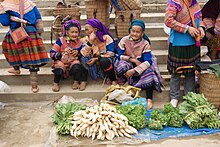
Staple elements include fresh herbs, vegetables such as leafy greens and hot peppers, steamed rice, and small amounts of meat, often chicken meat. Herbs are of major importance as both a food, a flavoring agent, and traditional medicine. Common southeast Asian sauces such as oyster and fish sauce feature prominently, although a fresh sauce called "pepper dip" which is unique to Hmong cuisine is so popular that the first ever Hmong cookbook included 11 variations.
Cooking is traditionally done by steaming or boiling and many dishes are prepared as simple stews or soups. In the modern Hmong diaspora, other forms of cooking such as stir frying have become common. Historically the animal fats and oils required for frying were scarce.

There is an emphasis on fresh ingredients, as many Hmong are farmers and may pick ingredients from a garden just before cooking. Butchering for meat is also done close to the time of cooking. Frugality is a common theme, as many Hmong are from low-income backgrounds, especially Hmong Americans who immigrated from underfunded refugee camps. Prior to the 21st century, Hmong lived mostly in self-sustaining agricultural villages where they raised livestock and grew crops.
Hmong cuisine as fusion
See also: Fusion cuisine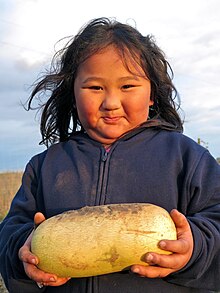
Co-founder and executive director of the Hmong American Farmers Association Pakou Hang calls Hmong cuisine "the ultimate fusion food". Hmong cuisine is influenced by frequent ancient and modern migration, including through Thailand, Laos, Cambodia, Vietnam, China, Japan, South Korea, and even the United States, Canada, Mexico, and Argentina. Some sources claim Hmong food is closest to Laotian cuisine, but the diversity of Hmong backgrounds complicates the idea of a single origin. For example, some Hmong identify with their country of settlement even among other Hmong, such as Thai Hmong, Lao Hmong, and Hmong American, which greatly influences their cuisine.
Hmong American celebrity chef Yia Vang calls Hmong cuisine a "philosophy" and a way to understand Hmong culture.

I would tell people that Hmong food is not just a type of food. It’s not about the product. It’s a philosophy. If you want to know Hmong food, you have know our people. Our story is intricately woven into the food that we eat. It’s our culture DNA that's made out of food that we eat. If you want to know our people you have to know our food. By knowing our food, you will know our story. You'll know where we been and it will show the trajectory to where we’re going.
— Chef Yia Vang at Industry Rules Magazine,
Scholars such as Alison Hope Alkon and Kat Vang, writing in The Immigrant-Food Nexus: Borders, Labor, and Identity in North America (2020), call Hmong cuisine translocal: a cuisine rooted in multiple localities and highly informed by ethnic culture and history regardless of state definitions of citizenship. They categorized food from Hmong American survey respondents in four categories: indigenous Hmong dishes, Hmong American dishes, Hmong adaptations of other Southeast Asian dishes, and American food eaten by Hmong people.
Common Hmong dishes
Dishes popular among Hmong people, served in a Hmong style, or unique to Hmong cuisine.
Kua txob ntsw (pepper dip)
A condiment made with Thai chilis, cilantro, green onion, salt, monosodium glutamate, fish sauce, and lime juice that is served at most meals, and especially to accompany Hmong sausage. The condiment is known by its Hmong name kua txob ntsw, or in English as pepper dip, pepper condiment, hot chili condiment, or simply "pepper".
Mov nplaum ntshaav (purple sticky rice)
A preparation of glutinous sweet rice and black rice which is a core part of Hmong meals, especially during New Years celebrations. Cooking dilutes the natural dye in black rice, leading to a purple colored rice dish. In areas where black rice is uncommon, the rice may be dyed with purple cornstalk or purple carrots.
Nyhuv ntxwm hmoob (Hmong sausage)
Further information: Hmong sausage
A fresh pork sausage seasoned with herbs like lemongrass and Kaffir lime leaf. Usually served with purple sticky rice and pepper dip.
Kooj tis qaib nitim (stuffed chicken wings)
Deboned chicken wings stuffed with a meat mixture such as from an egg roll.
Kab yaub (egg rolls)

Traditional "Hmong" egg rolls can be culturally tied back to Vietnamese egg rolls during their migration across Asia. These fried and flour wrapped rolls can be found at family events and annual events such as the Hmong New Year. The Hmong community of Rhode Island holds an annual fundraiser by selling traditional Hmong egg rolls.
Each family has their own recipe, but typically the rolls consist of eggs mixed with shredded carrots and cabbage, ground pork, onions, scallions, and cilantro. These are seasoned with oyster sauce, rolled in a paper-thin wheat shell, and deep fried.
Nab vam (tri-color)
Dyed tapioca jelly with a sweet coconut sauce. Nab vam (pronounced as Nah-vah) is a traditional Hmong drink that is occasionally served during special events. In English, it can sometimes be called “tri-color”. Naab vaam is a sweetened dessert drink that consists of coconut, tapioca pearls, cendol, and many other toppings that are mixed in. In Hmong culture, it is essential to have toppings such as colored chestnuts, gelatin, sweet fruit, and grass jelly. Most of these toppings can be made from scratch by using sugar, coconut milk, and rice flour.
Khaub piaj/ko pia (chicken soup with rice noodles)
A simple chicken soup with homemade rice noodles adopted from the Lao. There are various names and spellings such as khaub piaj and ko pia or kopia.
Zaub qaub (pickled mustard greens)
Further information: Pickled mustardMustard greens fermented in rice water or salt and vinegar. Commonly served with a meat dish such as Hmong sausage and sticky rice.
Agricultural traditions

Hmong people are traditionally agricultural. Diaspora communities in the United States are known for their thriving home and community garden spaces, as well as strains of plants unique to Hmong seed keepers. Hmong New Year, the most major annual event, is centered around the annual rice harvest and involves nearly a week of feasts and whole roasted pigs. Rice is considered the Hmong staple crop and is incorporated in most meals. Maize is an alternate staple crop for some Hmong villages.
A study of six Hmong villages in Northern Thailand found that vegetable stems and leaves were the main form of food, and the Hmong villagers consumed a total of 130 different species of vegetable. The most common preparations were raw or boiled in chicken soup. While many vegetables were cultivated, some were foraged from surrounding forests. Hmong cultivation of endangered plants for food was found to indirectly support their conservation.
Some key crops that Hmong American farmers produce are amaranth, bitter melon, mini and regular bitterball, Chinese long beans, cucuzza squash, gai lon (gai lan, Chinese broccoli), "Hmong corn", Hmong cucumbers, and "Hmong greens" yu choy.
Herbs
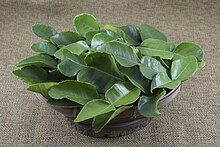
Herbs are used as food, seasoning, and traditional medicine—frequently all three at once.
Hmong Americans tend to grow herbs in small pots and plots at home so they are close at hand for harvesting fresh and cooking quickly. Fresh herbs are so central to traditional Hmong cuisine, one participant in a Fresno, California majority-Hmong community garden said: "If you see pots outside with cilantro and , you know this is Hmong family."
A common herb combination is "chicken herbs": a bundle that includes usually eight herbs used to flavor a chicken soup from traditional Hmong medicine (Nqaij Qaib Hau Xyaw Tshuaj). The recipe is considered by some to be the signature Hmong dish.
Common herbs in tshuaj rau qaib (chicken soup herbs) mixture:
- Ncas liab
- Ntiv (Joe-pye weed strain)
- Zej tshua ntuag
- Koj liab/ko taw os liab
- Tshuaj rog liab
- Nkaj liab Hmoob (Iresine)
- Pawj qaib (grassy-leaved sweet flag)
- Xuv ntsim
- Tauj dub (Cymbopogon citratus, known as lemon grass)
- Nroj rog liab (Okinawan spinach)
- Limnophila rugosa
- Sedum sarmentosum
Livestock
Hmong traditionally raise livestock such as chickens, cattle, and pigs. Chicken is a common meat while meats such as beef and pork were reserved for special occasions. In the 2000s an estimated 600 Hmong poultry farms existed in the United States, particularly in Southern states such as Arkansas, Missouri, Oklahoma, and North Carolina. Chicken is core to Hmong cuisine and additionally serves ritual purposes and features in traditional embroidery.
Hunting, fishing, and foraging meat remain a significant supplement to livestock, even for Hmong diaspora in the United States. A study of Hmong households in Wisconsin recorded that 60% regularly hunted and fished, which was twice the rate of the general population.
Hmong American cuisine
See also: Hmong Americans, History of the Hmong in Minneapolis–Saint Paul, and History of the Hmong in California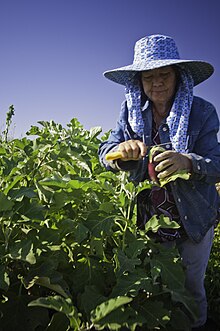
Mass immigration of Hmong refugees from Southeast Asia in the 1980s after the Laotian Civil War led to a sizable population of Hmong people in the United States, primarily Fresno, California and Saint Paul, Minnesota. These Hmong adapted their own Southeast Asian cuisine to the realities of refugee camps in Thailand and poverty in the United States. Dishes tend to be small but flavorful, seasoned generously with herbs and spices. Rice is a staple in meals to balance out strong flavors. Hmong-style American food such as spiced hamburgers is sometimes called "Mee-Ka".
Hmong American scholar Kou Yang says that Hmong American cuisine is distinct from other cusines of the Hmong diaspora because it incorporates a large amount of national cuisines from Asia with a number of Western cuisines including American and French.
Hmong American households tend to be smaller than traditional Hmong households, with an average of three people per household and a focus on nuclear family versus extended tribe and clan ties, changing how food is produced and consumed, including making smaller meals. Hmong Americans born abroad who grew up in America may identify as a third culture kid, a child who was influenced by an exceptionally large amount of cultures and as a result feels they have their own new culture, especially around food. Some sources also describe this as the "one-and-a-half generation". Hmong households in Minnesota were found to have the highest frequency of family meals and adolescent involvement in food preparation, versus other ethnic groups.
Holidays and religion
While Christian and American holidays are widely adopted, they are celebrated in distinctly Hmong ways with traditional costumes and Hmong cuisine. A Thanksgiving meal might look like rice, Hmong sausage, and boiled chicken alongside the traditional American turkey, mashed potatoes, and gravy. Hmong sausage is a common dish during Hmong New Years celebrations and at other large gatherings such as festivals and graduations. It is typically served with purple sticky rice, a preparation for naturally dyed glutinous rice.
Because many Hmong American Christians do not eat food made with blood, during mixed gatherings with Christians and traditional animists multiple forms of foods are prepared with and without blood.
Commercial food preparation
Yia Vang runs a popular restaurant called Union Hmong Kitchen in Minneapolis, Minnesota.
Hmongtown Marketplace in Saint Paul, Minnesota serves a variety of Hmong-style foods.
In popular culture

- Chef Yia Vang featured Hmong food in Iron Chef: Quest for an Iron Legend episode six, "Battle Chili Peppers".
- Dishes from Hmongtown Marketplace vendors were featured in 2019 as part of CNN's Emmy Award-winning United Shades of America with owner Toua Xiong and local Hmong American chef Yia Vang.
- Award-winning Hmong American poet May Lee-Yang writes about Hmong food culture such as in The Things a Hmong Woman Loves: "a Hmong Woman loves baby / cucumbers, unripened papayas, and green mangoes / anything she can dip with chili peppers and fish sauce / to spice up her life"
Gallery
-
 Laotian bowl of Pheu Hmong at Sunday Market in French Guiana
Laotian bowl of Pheu Hmong at Sunday Market in French Guiana
-
 An ethnic Hmong marketplace in Laos
An ethnic Hmong marketplace in Laos
-
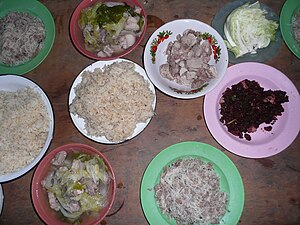 A Hmong dinner table
A Hmong dinner table
-
 Pea shoots for sale from a Hmong farmers market vendor in California
Pea shoots for sale from a Hmong farmers market vendor in California
-
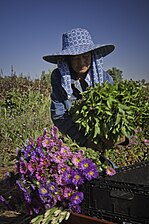 A Hmong farmer harvesting flowers and herbs in California
A Hmong farmer harvesting flowers and herbs in California
-
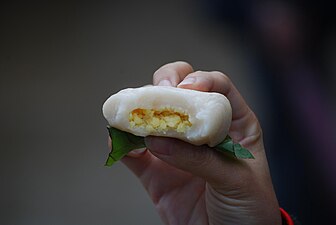 Mung bean cake at Bắc Hà Sunday Market in Vietnam
Mung bean cake at Bắc Hà Sunday Market in Vietnam
-
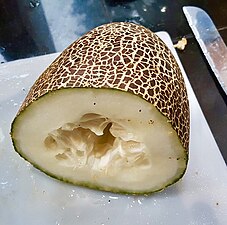 A varietal of cucumber grown by the Hmong people
A varietal of cucumber grown by the Hmong people
-
 Hmong goat head soup meal at Bắc Hà Sunday Market in Vietnam
Hmong goat head soup meal at Bắc Hà Sunday Market in Vietnam
-
 A Hmong specialities restaurant in Ha Giang city, Vietnam, in 2014
A Hmong specialities restaurant in Ha Giang city, Vietnam, in 2014
See also
References
- ^ Alkon & Vang 2020, p. 270
- ^ Bankston 2014
- Scripter & Yang 2009
- Scripter & Yang 2009, p. 6
- ^ Alkon & Vang 2020, p. 262
- ^ John, Steven (4 March 2015). "Appetites: Hmong cuisine, 'the ultimate fusion food'". MPR News. Minnesota Public Radio. Retrieved 2 November 2023.
- Alkon & Vang 2020, p. 263
- Harris, Phyllis Louise (2007-11-22). "The elusive Hmong cuisine". Twin Cities Daily Planet. Retrieved 2023-10-26.
- Vang 2009, p. 92
- ^ ArtFormss (2023-10-01). "Chef Yia Vang". Industry Rules. Retrieved 2023-10-26.
- ^ Alkon & Vang 2020, p. 269
- "Hot Chili Condiment". www.splendidtable.org. Retrieved 2023-10-24.
- ^ Vang 2009, p. 67
- Her, Cindy (2020-12-12). "Purple Sticky Rice: Mov Nplaum Ntshaav - C.HerCreations". Retrieved 2023-10-26.
- Vang, Yia (2020-04-14). "Purple Sticky Rice". Bon Appétit. Retrieved 2023-10-26.
- ^ Mennecke, Rebecca (2020-11-25). "Make Purple Sticky Rice to Celebrate the Hmoob New Year". volumeone.org. Photos by Yia Lor. Retrieved 2023-10-26.
- "Prix Fixe Hmong Dinner". Rose City Book Pub. 2023-05-20. Retrieved 2023-10-24.
- ^ Ciampa, Gail (28 May 2014). "Traditional egg rolls are centerpiece of Providence Hmong Church fundraiser". Providence, RI: The Providence Journal. Retrieved 31 December 2017.
- Her, Cindy (2019-07-14). "Pork Egg Rolls (Kab Yaub) - C.HerCreations". Retrieved 2023-10-25.
- ourlittlenook. "Seriously, the Best Egg Rolls! Hmong Egg Rolls – Our Little Nook". Retrieved 2023-10-25.
- ourlittlenook. "Sweet Coconut Tapioca Dessert-Nab Vam – Our Little Nook". Retrieved 2023-10-25.
- "Tri-color Tapioca Pearl Coconut Milk Dessert, Nab Vam". 3 January 2021. Retrieved 2023-10-25.
- "Naab Vaam". 7 October 2021.
- Kathynomnom. "Khaub Piaj (Ko Pia)- Hmong Chicken Noodle Soup". Kathy Nom Nom. Retrieved 2023-10-26.
- Her, Cindy (1 June 2022). "Grandma's Pickled Mustard Greens: Puj's Zaub Qaub [Preserving Grandma's Recipe]". C.HawjCreations. Retrieved 11 November 2023.
- ^ L'Annunziata 2010
- Vang 2016, p. 942
- Vang 2009, p. 112
- ^ Nguanchoo, Varangrat; Srisanga, Prachaya; Swangpol, Sasivimon; Prathanturarug, Sompop; Jenjittikul, Thaya (2014). "Food plants in Hmong cuisine in Northern Thailand" (PDF). The Journal of Botany วารสารพฤกษศาสตรไทย. 6 (2): 131–145. Retrieved April 20, 2024.
- Turner, Bonnin & Michaud 2015, p. 40.
- Heilmann, Katherine (2011). "Production, Yield, and Market Analysis of Produce Raised by Minnesota Hmong American / Immigrant Farmers". University of Minnesota. Retrieved November 2, 2024.
{{cite journal}}: Cite journal requires|journal=(help) - L'Annunziata 2010, p. 111
- ^ "Cooking From The Heart: The Hmong Kitchen In America - Recipes". hmongcooking.com. Retrieved 2023-10-26.
- ^ Raemont, Nina. "Sharing Food: Qaib rau tshuaj (Hmong chicken in herbs)". The Minnesota Daily. Retrieved 2023-10-25.
- ^ "Hmong Medicinal Chicken Herb Starter Package - Tshuaj Rau Qaib Package". Hmong Specialty Plants & Herbs. Retrieved 2023-10-25.
- ^ Srithi, Kamonnate; Trisonthi, Chusie; Wangpakapattanawong, Prasit; Srisanga, Prachaya; Balslev, Henrik (May 26, 2012). "Plant Diversity in Hmong and Mien Homegardens in Northern Thailand". Economic Botany. 66 (2). Bronx, New York: The New York Botanical Garden Press: 192–206. Bibcode:2012EcBot..66..192S. doi:10.1007/s12231-012-9199-y. Retrieved April 25, 2024 – via Springer Link.
- Crum, Alexandra Hazel (2024). Medicines, Metabolites, and Pigments in Caryophyllales and Beyond (Doctor of Philosophy thesis). University of Minnesota. ProQuest 31327584. Retrieved October 30, 2024.
- Vang 2016, p. 953
- Chiu, Jeannie (2004). "'I Salute the Spirit of My Communities': Autoethnographic Innovations in Hmong American Literature". College Literature. 31 (3). The Johns Hopkins University Press: 43–69. doi:10.1353/lit.2004.0030. JSTOR 25115207. Retrieved April 21, 2024 – via JSTOR.
A triangular pattern with one jagged edge is known as "chicken tail" and evokes the chicken s important position in Hmong cuisine and as a ritual offering (22). A chicken is sacrificed at funerals, since it is believed to guide the soul of the deceased to the afterworld.
- Bussjaeger, Jackie A. (2020). "Down the Deer Path: Reflections on the Future of Hunting in America". Graduate Student Theses, Dissertations, & Professional Papers. University of Montana. Retrieved April 20, 2024.
As the study observed, connection to the natural world is a significant part of Hmong culture, though widely under-researched. On American soil, many Hmong have continued the hunting, fishing, and foraging practices they carried out while living in Laos. A 1993 study found that 60 percent of Hmong households in Green Bay, Wisconsin participated in hunting and fishing—more than twice the participation rate of Green Bay's general population.
- ^ Zonunpari, Angela (2023-08-22). "Minnesotans Line Up for Hmong Food from Yia Vang". Arts Midwest. Retrieved 2023-10-24.
- Pfeifer, Chiu & Yang 2013, pp. 43.
- Vang 2016, p. 939
- Pfeifer, Chiu & Yang 2013, pp. 75.
- "Gia Vang and Yia Vang on 'Hmonglish,' Iron Chef and leaving KARE 11". MPR News. 2022-06-15. Retrieved 2023-10-24.
- Trofholz, Amanda; Tate, Allan; Fulkerson, Jayne A; Hearst, Mary O; Neumark-Sztainer, Dianne; Berge, Jerica M (2019). "Description of the home food environment in Black, White, Hmong, Latino, Native American and Somali homes with 5–7-year-old children". Public Health Nutrition. 22 (5): 882–893. doi:10.1017/S136898001800280X. ISSN 1368-9800. PMC 7310517. PMID 30477596.
- Vang 2016, p. 965
- Vang 2016, p. 968
- "'Food Is A Universal Language': Chef Yia Vang Finds Home For Hmong Flavors In Minneapolis' North Loop - CBS Minnesota". www.cbsnews.com. 2021-10-28. Retrieved 2023-10-24.
- "Battle Chili Peppers". Iron Chef: Quest for an Iron Legend. Netflix.
- Jackson, Sharyn (19 May 2019). "CNN show 'United Shades of America' goes inside the home of Minnesota's rising star Hmong chef". Star Tribune. Retrieved 29 October 2023.
- Lee-Yang, May (2020). "The Things a Hmong Woman Loves". May Lee Yang. May Lee-Yang & Lazy Hmong Woman Productions. Retrieved 4 November 2023.
Cited
- Alkon AH, Vang K (24 March 2020). "13: Boiled Chicken and Pizza: The Making of Transnational Hmong American Foodways". In Agyeman J, Giacalone S (eds.). The Immigrant-Food Nexus: Borders, Labor, and Identity in North America. Food, Health, and the Environment. MIT Press. pp. 261–280. doi:10.7551/mitpress/11862.001.0001. ISBN 9780262538411.
- Bankston, Carl L. (2014). "Hmong Americans". In Riggs, Thomas (ed.). Gale Encyclopedia of Multicultural America. Vol. 2 (3rd ed.). Gale, part of Cengage Group. p. 336. Retrieved April 27, 2024 – via Gale Power Search.
White rice is the staple food of the Hmong. The dishes eaten with rice are often spiced with peppers in a manner similar to Thai food. The Hmong also eat noodle dishes that resemble a Vietnamese noodle soup known as pho, which has become popular in the United States. Common meat dishes include broiled chicken, lemongrass marinated pork, and sautéed chicken. The Hmong Americans often grow their own vegetables in gardens, including bitter melon, bok choi, eggplant, and turnips. Traditional foods are especially popular among Hmong Americans at the annual New Year festival.
- Cha, Ya Po (2010). An Introduction to Hmong Culture. Jefferson: North Carolina: McFarland & Company, Inc., Publishers. ISBN 978-0-7864-4951-4 – via Internet Archive.
- L'Annunziata, Elena (2010). "Following the Plant: The Political Ecology of a Hmong Community Garden". Humboldt Journal of Social Relations. 33 (1/2): 97–134. JSTOR 23263228 – via JSTOR.
- Lee, Gary Yia; Tapp, Nicholas (2010). Lu, Hanchao (ed.). Culture and Customs of the Hmong. Culture and Customs of Asia. Santa Barbara, California: Greenwood Publishing Group, an imprint of ABC-CLIO, LLC. ISBN 978-0-313-34526-5 – via Internet Archive.
- Pfeifer, Mark Edward; Chiu, Monica; Yang, Kou, eds. (January 31, 2013). Diversity in Diaspora. Honolulu, Hawaii: University of Hawaii Press. ISBN 978-0-8248-3777-8. Project MUSE 21545.
- Scripter, Sami; Yang, Sheng (2009). Cooking from the Heart: The Hmong Kitchen in America. Minneapolis: University of Minnesota Press. ISBN 9781452914510. OCLC 286478281. Cooking from the Heart: The Hmong Kitchen in America at Google Books
- Turner, Sarah; Bonnin, Christine; Michaud, Jean (2015). Frontier Livelihoods: Hmong In the Sino-Vietnamese Borderlands. Seattle: University of Washington Press. ISBN 978-0-295-99466-6.
- Vang, Chia Youyee (24 July 2009). Hmong in Minnesota. People of Minnesota. Minnesota Historical Society Press. ISBN 9780873517379.
- Vang, Nengher N. (13 March 2016). "Hmong American Culture". In Dong, Lan (ed.). Asian American Culture: From Anime to Tiger Moms. Cultures of the American Mosaic. Bloomsbury Publishing. ISBN 978-1440829208.
Further reading
- Burckhardt, Ann (2004). "Family Reunions + Feasting = Hmong New Year". A Cook's Tour of Minnesota. Minnesota Historical Society Press. pp. 39–54. ISBN 9780873514682. A Cook's Tour of Minnesota at Google Books
- Carman, Tim (December 26, 2018). "In the Twin Cities, Asian chefs feel the sting of Andrew Zimmern's insults. They say his apology isn't enough". Washington Post. EBSCOhost wapo.77beee1e-ff37-11e8-862a-b6a6f3ce8199. Retrieved November 18, 2024.
- More Best Ever Food Review Show (October 17, 2021). NOT For Newbies!! The Asian Food You've NEVER SEEN Before!! (video). Retrieved October 21, 2024 – via YouTube.
External links
- Agriculture & Land Relations in Hmong Culture from Learn Uake
- Hmong recipe website from the authors of Cooking from the Heart: The Hmong Kitchen in America
- What is authenticity in food? essay by Union Hmong Kitchen's Yia Vang and Ming-Jinn Tong
- Culinary culture of the Hmong people Hmong Food